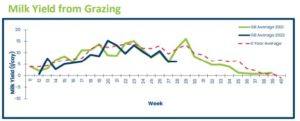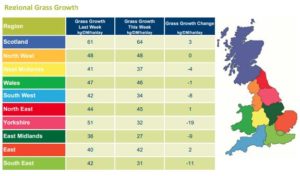Grass Growth
As expected with the extremely hot weather and limited rainfall, average grass growth across GB has declined over the last week to 40.6kg DM/ha/day and continues to be below levels recorded for the last 3 years. With the continued hot and dry weather forecast for much of the country, grass growth will likely remain significantly below averages for the next week. With available grass becoming a potentially limiting factor on intakes it is important to target the best quality forage to the most productive cattle and supplement other fibre sources where needed. It is also important to adjust concentrate supplementation to the forage that is available, reducing expectations of performance from forage where applicable.
Milk Yield from Grazing (MYFG)
Average MYFG has remained almost constant this week for GB at M+6.2litres/day. Regionally, the Northwest sees the highest potential at M+11litres/day while the Northeast and Yorkshire sees the lowest average of M+3.5litres/day. It is important to remember that increased risk of heat stress at higher temperatures means cows tend to decrease their milk production.
Managing Heat Stress
With more amber/red level warnings issued for the week and highs in temperature of up to 40 degrees Celsius, the risk of heat stress is extremely high. Heat stress ultimately impacts on milk yield, with heat stressed cows expecting up to 2.7kg/cow/day less milk thanks to reduced DMI and increases in metabolic regulation
- To aid in counteracting the effects of heat stress, consider the following:
- Access to clean, fresh drinking water.
- During hot weather cattle substantially increase their water intake, to replace water lost through respiration and perspiration. Water consumption is also the quickest method for cattle to reduce their core temperatures.
- Access to shade:
- The provision of shade can help cattle manage heat stress, through reducing solar heat load on the animals.Adjust diets accordingly to dry matter intake decrease
- Through increasing energy density of diets and ensuring there is enough effective fibre to maximise rumination.
- Offer larger amounts of feed at cooler times of the day:
-
- This can help with the cow’s metabolic requirement for cooling down as internal temperatures as ruminal fermentation produces heat.

